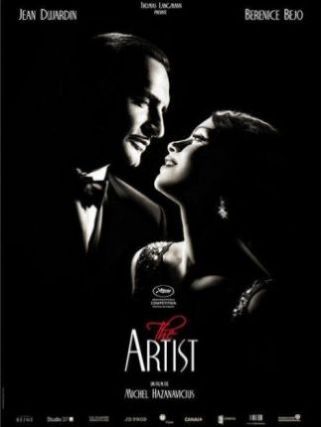
This week in my movie class, we saw the drama, “The Artist”, starring a couple of French actors you probably don’t know, but John Goodman, Penelope Ann Miller and James Cromwell appear in major supporting roles.
Synopsis
After a silent-screen movie star falls upon hard times when “Talkies” arrive, will he be able to regain his stature?
Story
In the Hollywood of 1927, George Valentin (Jean Dujardin) seemed to rule the world as a star of silent movies. At a chance encounter during a photo opportunity following his latest movie premiere, he meets an aspiring actress by the name of Peppy Miller (Bérénice Bejo), who is star-struck at his presence. After his jealous wife Doris (Miller) becomes suspicious upon seeing their picture in the paper, George unsuccessfully tries to convince her that he is not cheating. But after Peppy runs into him again after auditioning for a movie role, George saves her job when studio head Al Zimmer (Goodman) tries to fire her.
Although she admits to George that she has something of a crush on him, he and Peppy soon realize that their mutual attraction must go unfulfilled because he is married. Becoming dedicated to her career as a result, Peppy works hard and gradually rises through the ranks to earn bigger and better parts in subsequent movies. Within the next couple of years, however, modern technology delivers sound to movies and Zimmer sees that this is the future of his business. Realizing that this era of “talkies” brings with it a demand from audiences for fresh faces, he fires George; at the same time, Peppy – a relative unknown – gains increasing prominence and becomes blessed with stardom in the early days of talkies.
Finding himself without the backing of a movie studio, George funds his own movies, acting as writer-director-producer-star. The only problem is that he continues to make silent films at a time when audiences are now captivated by moving pictures with sound – his movie flops and he loses even more of his fortune when the stock market crashes. With Doris having left him, his only companions now are his pet dog and Clifton (Cromwell) – his chauffeur from the good old days who stays with his old boss during lean times out of loyalty. But when George is now forced to live like a pauper and turns to drink, will he completely give up on himself or will he be able to find a way to revive his career?
Review
As I usually do, I have placed a trailer for the current review’s movie at the end of this post; that said, the following sums up my feelings about “The Artist” – regardless of whether or not you have read this review, if you can resist seeing this movie after viewing the trailer below, then quite simply, you don’t deserve to see a movie quite this good. “The Artist” is one of those films that reminds you of just how much magic movies can possess – and if you consider yourself a movie buff (in particular, a fan of films from the 1920’s and 1930’s), then quite frankly, how can you not see this movie?
Having said all of that, I will tell you that if you haven’t yet viewed the trailer, there are two very important things that you should know about “The Artist”: 1) It is in black & white, not color; and 2) It is a silent film. Yep, you read that right – this is a silent film about silent films! Daring? You betcha (as Sarah Palin might say), especially in this day and age. But if you don’t absolutely fall in love with this adorable movie that in itself is something of an homage to films of this era, then you just plain don’t love movies. Period. In addition to the above two caveats that I mentioned, it doesn’t feature any major Hollywood stars and is actually a French-funded picture – if you don’t consider any of those things a strike against “The Artist” then you are guaranteed to fall head-over-heels in love with this movie.
Prior to the screening, our instructor interviewed Penelope Ann Miller, who was all dolled-up because she was in town to attend the movie’s premiere. During the interview, she recounted her experience with being offered her role of Doris in “The Artist” – she was sent a very untraditional script because it had no dialog. Instead, she said that it felt like she was reading something between a short story and a comic book because the screenplay had no dialog – it was mostly just narrative, occasionally broken up with small storyboard-like drawings to serve as illustrations for key parts of scenes. Clearly enthusiastic about this unusual movie, she nevertheless had to leave the class prior to our viewing so that she could return to the Manhattan theater where the premiere occurred so she could be interviewed by the press.
No comments:
Post a Comment
Speak Your Piece, Beeyotch!